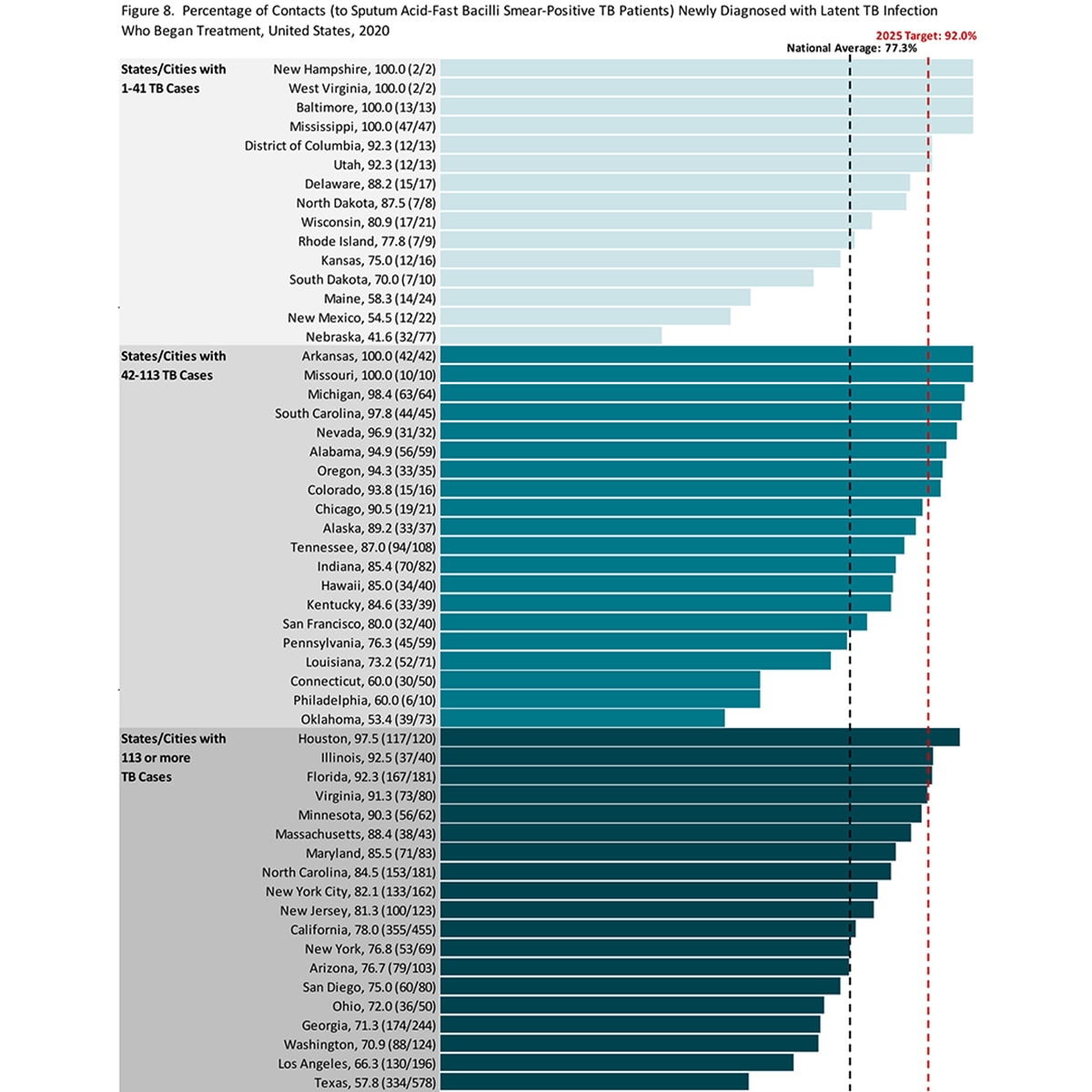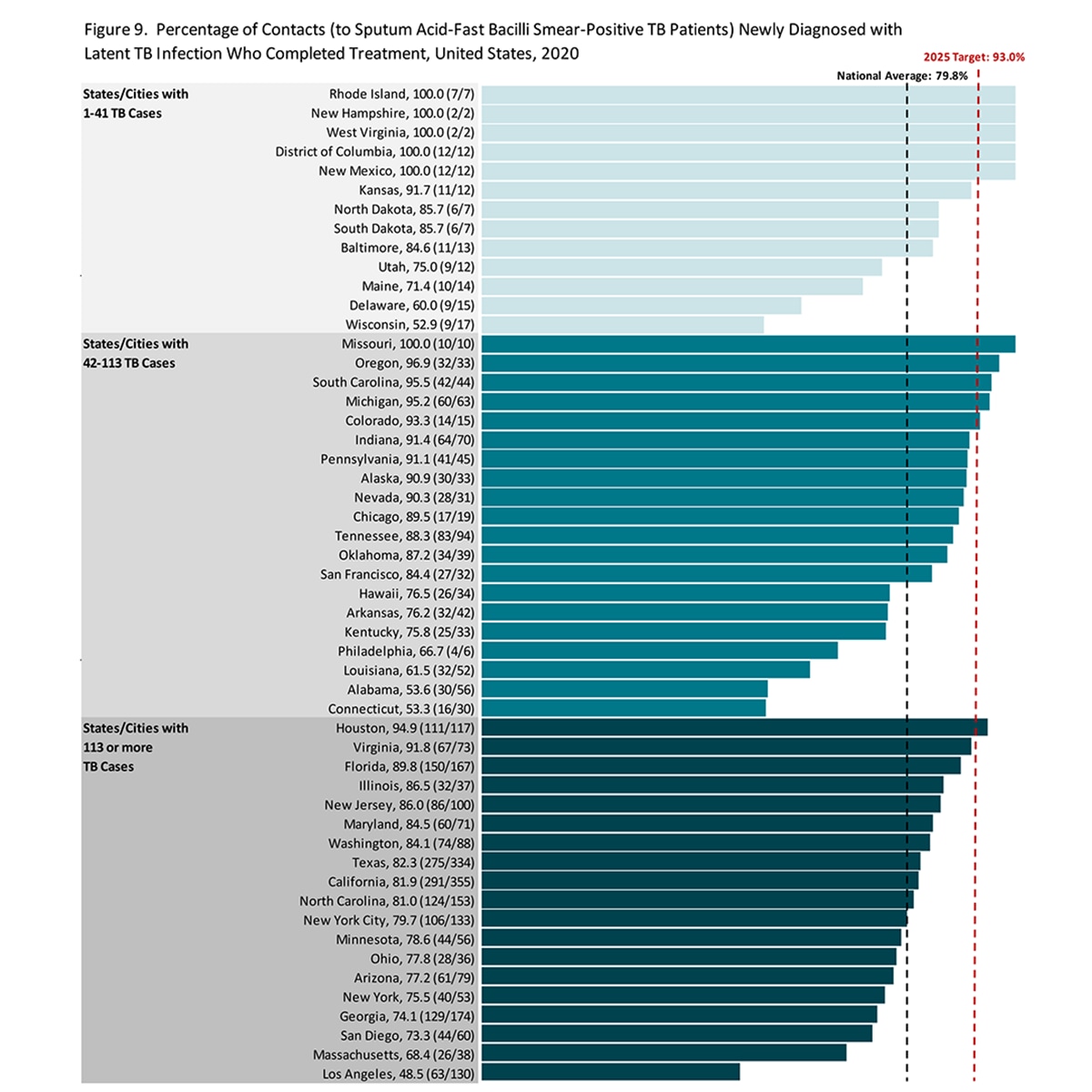Key points
In 2020, the most recent year for which data are available, 17 states and cities met or exceeded the 2025 national target of initiating treatment for 92.0% of people diagnosed with latent tuberculosis (TB) infection who were found during contact investigations.
Overview
When a person with infectious TB disease coughs (sings or talks), droplet nuclei containing M. tuberculosis are expelled into the air. If another person inhales air containing these droplet nuclei, he or she might become infected. However, not everyone infected with TB bacteria develops symptoms of TB. As a result, two TB-related conditions exist: latent TB infection and TB disease.
Persons with latent TB infection do not feel sick and do not have any symptoms. They are infected with M. tuberculosis, but do not have TB disease at that time. The only sign of latent TB infection is a positive reaction to a TB skin test or TB blood test.
Persons with latent TB infection are not infectious and cannot spread TB to others. However, at some point in their lives, 5–10% of all people with normal immune systems who have latent TB infection will become sick with TB disease. As previously described, the chances of progression from latent TB infection to TB disease are higher for persons with weakened immune systems, such as those infected with HIV. Latent TB infection can be treated to prevent the risk of progression to TB disease. Thus, it is important, in terms of accelerating the decline in TB incidence, to measure how many people with latent TB infection are identified through targeted testing, begin treatment, and complete treatment.
Risk
TB programs work to identify persons who experience high risk for latent TB infection or experience high risk for developing TB disease once infected so that they can offer testing and treatment for latent TB infection. These persons include:
- Known close contacts of someone with infectious TB disease
- Persons from regions of the world with high TB incidence
- Those who work or reside in facilities or institutions with people who also experience high risk for TB
Risk factors for developing TB disease once infected include:
- HIV infection
- Injection drug use
- Evidence of prior healed TB disease
- Diabetes
- Low body weight
- Other illnesses or conditions that cause immunosuppression
Infants and children under the age of five years are also at higher risk of getting sick with TB disease once infected.
Contacts with latent TB infection who began treatment
In 2020, the most recent year for which data are available, 17 states and cities met or exceeded the 2025 national target of initiating treatment for 92.0% of people diagnosed with latent TB infection who were found during contact investigations; 19 states and cities were short of the 2025 target but exceeded the national average of 77.3%.

The fraction in each parenthesis reports the number of contacts who started treatment out of those contacts newly diagnosed with TB infection.
States/cities are grouped into thirds based on numbers of TB cases reported in 2020.
Due to the small denominator, data for states that reported 50 or fewer total TB cases should be interpreted with caution.
Contacts with latent TB infection who completed treatment
In 2020, 11 states and cities met or exceeded the 2025 national target of treatment completion for 93.0% of people diagnosed with latent TB infection through contact investigation who started treatment; 21 states and cities were short of the 2025 target but met or exceeded the national average of 79.8%.

The fraction in each parenthesis reports the number of contacts newly diagnosed with TB infection who completed treatment out of those contacts who started treatment.
States/cities are grouped into thirds based on numbers of TB cases reported in 2020.
Due to the small denominator, data for states that reported 50 or fewer total TB cases should be interpreted with caution.
- Aggregate Reports for Program Evaluation as of August 26, 2022
